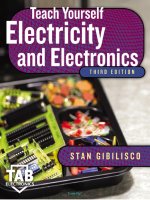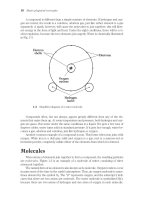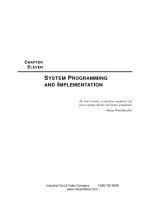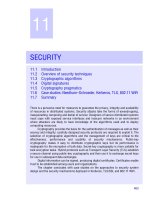Ebook Teach yourself electricity and electronics (4th edition): Part 1
Bạn đang xem bản rút gọn của tài liệu. Xem và tải ngay bản đầy đủ của tài liệu tại đây (2.94 MB, 332 trang )
Teach Yourself
Electricity and
Electronics
This page intentionally left blank
Teach Yourself
Electricity and
Electronics
Fourth Edition
Stan Gibilisco
McGraw-Hill
New York Chicago San Francisco Lisbon London Madrid
Mexico City Milan New Delhi San Juan Seoul
Singapore Sydney Toronto
Copyright © 2006, 2002, 1997, 1993 by The McGraw-Hill Companies, Inc. All rights reserved. Manufactured in the United
States of America. Except as permitted under the United States Copyright Act of 1976, no part of this publication may be reproduced or distributed in any form or by any means, or stored in a database or retrieval system, without the prior written permission of the publisher.
0-07-148709-3
The material in this eBook also appears in the print version of this title: 0-07-145933-2.
All trademarks are trademarks of their respective owners. Rather than put a trademark symbol after every occurrence of a trademarked name, we use names in an editorial fashion only, and to the benefit of the trademark owner, with no intention of infringement of the trademark. Where such designations appear in this book, they have been printed with initial caps.
McGraw-Hill eBooks are available at special quantity discounts to use as premiums and sales promotions, or for use in corporate training programs. For more information, please contact George Hoare, Special Sales, at
or (212) 904-4069.
TERMS OF USE
This is a copyrighted work and The McGraw-Hill Companies, Inc. (“McGraw-Hill”) and its licensors reserve all rights in and to
the work. Use of this work is subject to these terms. Except as permitted under the Copyright Act of 1976 and the right to store
and retrieve one copy of the work, you may not decompile, disassemble, reverse engineer, reproduce, modify, create derivative
works based upon, transmit, distribute, disseminate, sell, publish or sublicense the work or any part of it without McGraw-Hill’s
prior consent. You may use the work for your own noncommercial and personal use; any other use of the work is strictly prohibited. Your right to use the work may be terminated if you fail to comply with these terms.
THE WORK IS PROVIDED “AS IS.” McGRAW-HILL AND ITS LICENSORS MAKE NO GUARANTEES OR WARRANTIES AS TO THE ACCURACY, ADEQUACY OR COMPLETENESS OF OR RESULTS TO BE OBTAINED FROM
USING THE WORK, INCLUDING ANY INFORMATION THAT CAN BE ACCESSED THROUGH THE WORK VIA
HYPERLINK OR OTHERWISE, AND EXPRESSLY DISCLAIM ANY WARRANTY, EXPRESS OR IMPLIED, INCLUDING
BUT NOT LIMITED TO IMPLIED WARRANTIES OF MERCHANTABILITY OR FITNESS FOR A PARTICULAR PURPOSE. McGraw-Hill and its licensors do not warrant or guarantee that the functions contained in the work will meet your requirements or that its operation will be uninterrupted or error free. Neither McGraw-Hill nor its licensors shall be liable to you or anyone else for any inaccuracy, error or omission, regardless of cause, in the work or for any damages resulting therefrom. McGrawHill has no responsibility for the content of any information accessed through the work. Under no circumstances shall McGrawHill and/or its licensors be liable for any indirect, incidental, special, punitive, consequential or similar damages that result from
the use of or inability to use the work, even if any of them has been advised of the possibility of such damages. This limitation
of liability shall apply to any claim or cause whatsoever whether such claim or cause arises in contract, tort or otherwise.
DOI: 10.1036/0071459332
Professional
Want to learn more?
We hope you enjoy this
McGraw-Hill eBook! If
you’d like more information about this book,
its author, or related books and websites,
please click here.
To Tony, Samuel, Tim, Roland, Jack, and Sherri
This page intentionally left blank
For more information about this title, click here
Contents
Preface
Part 1
xvii
Direct Current
1 Basic Physical Concepts
Atoms 3
3
Protons, Neutrons, and Atomic Numbers 3
Isotopes and Atomic Weights 4
Electrons 4
Ions 6
Compounds 6
Molecules 7
Conductors 8
Insulators 8
Resistors 9
Semiconductors 9
Current 10
Static Electricity 11
Electromotive Force 12
Nonelectrical Energy 13
Quiz 14
2 Electrical Units 17
The Volt 17
Current Flow 18
The Ampere 19
Resistance and the Ohm 20
Conductance and the Siemens 22
Power and the Watt 23
vii
viii
Contents
A Word about Notation 24
Energy and the Watt-Hour 25
Other Energy Units 26
Alternating Current and the Hertz 27
Rectification and Pulsating Direct Current 28
Safety Considerations in Electrical Work 30
Magnetism 30
Magnetic Units 32
Quiz 32
3 Measuring Devices
36
Electromagnetic Deflection 36
Electrostatic Deflection 38
Thermal Heating 39
Ammeters 39
Voltmeters 41
Ohmmeters 43
Multimeters 44
FET Voltmeters 44
Wattmeters 45
Watt-Hour Meters 46
Digital Readout Meters 46
Frequency Counters 47
Other Meter Types 47
Quiz 51
4 Direct-Current Circuit Basics
Schematic Symbols 55
55
Schematic and Wiring Diagrams 56
Voltage/Current/Resistance Circuits 57
Ohm’s Law 58
Current Calculations 59
Voltage Calculations 60
Resistance Calculations 60
Power Calculations 61
Resistances in Series 62
Resistances in Parallel 63
Division of Power 64
Resistances in Series-Parallel 64
Quiz 65
5 Direct-Current Circuit Analysis
69
Current through Series Resistances 69
Voltages across Series Resistances 70
Voltage across Parallel Resistances 72
Currents through Parallel Resistances 72
Contents ix
Power Distribution in Series Circuits 74
Power Distribution in Parallel Circuits 74
Kirchhoff ’s First Law 75
Kirchhoff ’s Second Law 77
Voltage Divider Networks 78
Quiz 80
6 Resistors
85
Purpose of the Resistor 85
Fixed Resistors 88
The Potentiometer 90
The Decibel 93
Resistor Specifications 94
Quiz 98
7 Cells and Batteries
102
Electrochemical Energy 102
Grocery Store Cells and Batteries 105
Miniature Cells and Batteries 106
Lead-Acid Batteries 107
Nickel-Based Cells and Batteries 108
Photovoltaic Cells and Batteries 109
Fuel Cells 110
Quiz 111
8 Magnetism
115
The Geomagnetic Field 115
Causes and Effects 116
Magnetic Field Strength 120
Electromagnets 120
Magnetic Properties of Materials 122
Practical Magnetism 123
Quiz 128
Test: Part 1
Part 2
132
Alternating Current
9 Alternating-Current Basics
143
Definition of Alternating Current 143
Period and Frequency 143
The Sine Wave 144
Square Waves 145
Sawtooth Waves 146
Complex and Irregular Waveforms 147
x Contents
Frequency Spectrum 148
Fractions of a Cycle 150
Expressions of Amplitude 151
The Generator 154
Why Alternating and Not Direct? 155
Quiz 156
10 Inductance
160
The Property of Inductance 160
Practical Inductors 161
The Unit of Inductance 162
Inductors in Series 162
Inductors in Parallel 163
Interaction among Inductors 164
Air-Core Coils 166
Ferromagnetic Cores 166
Inductors at RF 169
Unwanted Inductances 171
Quiz 171
11 Capacitance
175
The Property of Capacitance 175
Practical Capacitors 176
The Unit of Capacitance 177
Capacitors in Series 177
Capacitors in Parallel 178
Fixed Capacitors 179
Variable Capacitors 182
Capacitor Specifications 184
Interelectrode Capacitance 184
Quiz 185
12 Phase
188
Instantaneous Values 188
Instantaneous Rate of Change 189
Circles and Vectors 190
Expressions of Phase Difference 192
Vector Diagrams of Phase Difference 195
Quiz 196
13 Inductive Reactance
200
Coils and Direct Current 200
Coils and Alternating Current 201
Reactance and Frequency 202
Points in the RL Plane 203
Vectors in the RL Plane 205
Contents xi
Current Lags Voltage 205
How Much Lag? 208
Quiz 210
14 Capacitive Reactance
214
Capacitors and Direct Current 214
Capacitors and Alternating Current 215
Capacitive Reactance and Frequency 216
Points in the RC Plane 218
Vectors in the RC Plane 219
Current Leads Voltage 220
How Much Lead? 222
Quiz 225
15 Impedance and Admittance 229
Imaginary Numbers 229
Complex Numbers 229
The RX Plane 233
Characteristic Impedance 236
Conductance 238
Susceptance 238
Admittance 240
The GB plane 240
Quiz 242
16 RLC and GLC Circuit Analysis 245
Complex Impedances in Series 245
Series RLC Circuits 248
Complex Admittances in Parallel 250
Parallel GLC Circuits 253
Putting It All Together 256
Reducing Complicated RLC Circuits 257
Ohm’s Law for AC Circuits 259
Quiz 261
17 Power and Resonance in Alternating-Current Circuits
Forms of Power 265
True Power, VA Power, and Reactive Power 268
Power Transmission 273
Resonance 276
Resonant Devices 280
Quiz 282
18 Transformers and Impedance Matching
Principle of the Transformer 286
Geometries 289
286
265
xii Contents
Power Transformers 292
Isolation and Impedance Matching 294
Radio-Frequency Transformers 297
Quiz 299
Test: Part 2
Part 3
303
Basic Electronics
19 Introduction to Semiconductors 315
The Semiconductor Revolution 315
Semiconductor Materials 316
Doping and Charge Carriers 317
The P-N Junction 318
Quiz 321
20 How Diodes Are Used
Rectification 325
Detection 326
325
Frequency Multiplication 326
Signal Mixing 327
Switching 328
Voltage Regulation 328
Amplitude Limiting 329
Frequency Control 330
Oscillation and Amplification 330
Energy Emission 331
Photosensitive Diodes 332
Quiz 333
21 Power Supplies
337
Power Transformers 337
Rectifier Diodes 338
Half-Wave Circuit 338
Full-Wave Center-Tap Circuit 340
Full-Wave Bridge Circuit 340
Voltage-Doubler Circuit 341
Filtering 342
Voltage Regulation 344
Protection of Equipment 345
Quiz 348
22 The Bipolar Transistor
NPN versus PNP 352
Biasing 353
352
Contents xiii
Biasing for Amplification 355
Gain versus Frequency 357
Common Emitter Circuit 358
Common Base Circuit 359
Common Collector Circuit 359
Quiz 361
23 The Field Effect Transistor 365
Principle of the JFET 365
Amplification 369
The MOSFET 370
Common Source Circuit 373
Common Gate Circuit 374
Common Drain Circuit 375
Quiz 376
24 Amplifiers and Oscillators
The Decibel 379
379
Basic Bipolar Transistor Amplifier 381
Basic JFET Amplifier 382
Amplifier Classes 383
Efficiency in Power Amplifiers 386
Drive and Overdrive 388
Audio Amplification 389
Radio-Frequency Amplification 391
How Oscillators Work 393
Common Oscillator Circuits 394
Oscillator Stability 399
Audio Oscillators 400
Quiz 402
25 Wireless Transmitters and Receivers
Oscillation and Amplification 407
Modulation 407
Pulse Modulation 414
Analog-to-Digital Conversion 415
Image Transmission 416
The Electromagnetic Field 419
Wave Propagation 421
Transmission Media 423
Two Basic Receiver Designs 424
Predetector Stages 427
Detectors 429
Audio Stages 433
Television Reception 433
407
xiv Contents
Specialized Wireless Modes 434
Quiz 437
26 Digital Basics
441
Numbering Systems 441
Logic 443
Digital Circuits 444
Binary Digital Communications 448
The RGB Color Model 453
Quiz 454
Test: Part 3
Part 4
458
Specialized Devices and Systems
27 Antennas
471
Radiation Resistance 471
Half-Wave Antennas 473
Quarter-Wave Verticals 474
Loops 476
Ground Systems 477
Gain and Directivity 478
Phased Arrays 480
Parasitic Arrays 482
Antennas for Ultrahigh and Microwave Frequencies 483
Safety 486
Quiz 486
28 Integrated Circuits
491
Advantages of IC Technology 491
Limitations of IC Technology 492
Linear ICs 492
Digital ICs 496
Component Density 498
IC Memory 499
Quiz 499
29 Electron Tubes 504
Tube Forms 504
Electrodes in a Tube 505
Circuit Configurations 508
Cathode-Ray Tubes 509
Camera Tubes 511
Tubes for Use above 300 MHz 513
Quiz 514
Contents xv
30 Transducers, Sensors, Location, and Navigation
Wave Transducers 517
Displacement Transducers 519
Detection and Measurement 523
Location Systems 527
Navigational Methods 531
Quiz 534
31 Acoustics, Audio, and High Fidelity
Acoustics 538
Loudness and Phase 540
Technical Considerations 541
Components 541
Specialized Systems 546
Recorded Media 547
Electromagnetic Interference 549
Quiz 550
517
538
32 Personal and Hobby Wireless 554
Cellular Communications 554
Satellites and Networks 556
Amateur and Shortwave Radio 559
Security and Privacy 561
Quiz 566
33 A Computer and Internet Primer
The Central Processing Unit 569
Units of Digital Data 570
The Hard Drive 571
External Storage 573
Memory 574
The Display 575
The Printer 577
The Scanner 578
The Modem 580
The Internet 581
Quiz 584
569
34 Monitoring, Robotics, and Artificial Intelligence
Keeping Watch 587
Robot Generations and Laws 591
Robot Arms 592
Robot Hearing and Vision 597
Robot Navigation 600
587
xvi Contents
Telepresence 603
The Mind of the Machine 605
Quiz 606
Test: Part 4
610
Final Exam
621
Appendix A
Answers to Quiz, Test, and Exam Questions
Appendix B
Schematic Symbols
Suggested Additional Reading
Index
673
653
671
645
Preface
This book is for people who want to learn the fundamentals of electricity, electronics, and related
fields without taking a formal course. The book can also serve as a classroom text. This edition contains new material on transducers, sensors, antennas, monitoring, security, and navigation. Material
from previous editions has been updated where appropriate.
As you take this course, you’ll encounter hundreds of quiz, test, and exam questions that can
help you measure your progress. They are written like the questions found in standardized tests used
by educational institutions.
There is a short multiple-choice quiz at the end of every chapter. The quizzes are “open-book.”
You may refer to the chapter texts when taking them. When you have finished a chapter, take the
quiz, write down your answers, and then give your list of answers to a friend. Have the friend tell
you your score, but not which questions you got wrong. Because you’re allowed to look at the text
when taking the quizzes, some of the questions are rather difficult.
At the end of each section, there is a multiple-choice test. These tests are easier than chapterending quizzes. Don’t look back at the text when taking the tests. A satisfactory score is at least
three-quarters of the answers correct.
You will find a final exam at the end of this course. As with the section-ending tests, the questions are not as difficult as those in the chapter-ending quizzes. Don’t refer back to the text while
taking the final exam. A satisfactory score is at least three-quarters of the answers correct.
The answers to all of the multiple-choice quiz, test, and exam questions are listed in an appendix at the back of this book.
You don’t need a mathematical or scientific background for this course. Middle-school algebra,
geometry, and physics will suffice. There’s no calculus here! I recommend that you complete one
chapter a week. That way, in a few months, you’ll finish the course. You can then use this book, with
its comprehensive index, as a permanent reference.
Suggestions for future editions are welcome.
Stan Gibilisco
xvii
Copyright © 2006, 2002, 1997, 1993 by The McGraw-Hill Companies, Inc. Click here for terms of use.
This page intentionally left blank
1
PART
Direct Current
Copyright © 2006, 2002, 1997, 1993 by The McGraw-Hill Companies, Inc. Click here for terms of use.
This page intentionally left blank
1
CHAPTER
Basic Physical Concepts
IT IS IMPORTANT TO UNDERSTAND SOME SIMPLE, GENERAL PHYSICS PRINCIPLES IN ORDER TO HAVE A
full grasp of electricity and electronics. It is not necessary to know high-level mathematics. In science, you can talk about qualitative things or quantitative things, the “what” versus the “how
much.” For now, we are concerned only about the “what.” The “how much” will come later.
Atoms
All matter is made up of countless tiny particles whizzing around. These particles are extremely
dense; matter is mostly empty space. Matter seems continuous because the particles are so small,
and they move incredibly fast.
Each chemical element has its own unique type of particle, known as its atom. Atoms of different elements are always different. The slightest change in an atom can make a tremendous difference in its behavior. You can live by breathing pure oxygen, but you can’t live off of pure nitrogen.
Oxygen will cause metal to corrode, but nitrogen will not. Wood will burn furiously in an atmosphere of pure oxygen, but will not even ignite in pure nitrogen. Yet both are gases at room temperature and pressure; both are colorless, both are odorless, and both are just about of equal weight.
These substances are so different because oxygen has eight protons, while nitrogen has only seven.
There are many other examples in nature where a tiny change in atomic structure makes a major difference in the way a substance behaves.
Protons, Neutrons, and Atomic Numbers
The part of an atom that gives an element its identity is the nucleus. It is made up of two kinds of
particles, the proton and the neutron. These are extremely dense. A teaspoonful of either of these particles, packed tightly together, would weigh tons. Protons and neutrons have just about the same
mass, but the proton has an electric charge while the neutron does not.
The simplest element, hydrogen, has a nucleus made up of only one proton; there are usually
no neutrons. This is the most common element in the universe. Sometimes a nucleus of hydrogen
3
Copyright © 2006, 2002, 1997, 1993 by The McGraw-Hill Companies, Inc. Click here for terms of use.
4 Basic Physical Concepts
has a neutron or two along with the proton, but this does not occur very often. These “mutant”
forms of hydrogen do, nonetheless, play significant roles in atomic physics.
The second most abundant element is helium. Usually, this atom has a nucleus with two protons and two neutrons. Hydrogen is changed into helium inside the sun, and in the process, energy
is given off. This makes the sun shine. The process, called fusion, is also responsible for the terrific
explosive force of a hydrogen bomb.
Every proton in the universe is just like every other. Neutrons are all alike, too. The number of
protons in an element’s nucleus, the atomic number, gives that element its identity. The element with
three protons is lithium, a light metal that reacts easily with gases such as oxygen or chlorine. The element with four protons is beryllium, also a metal. In general, as the number of protons in an element’s nucleus increases, the number of neutrons also increases. Elements with high atomic numbers,
like lead, are therefore much denser than elements with low atomic numbers, like carbon. Perhaps
you’ve compared a lead sinker with a piece of coal of similar size, and noticed this difference.
Isotopes and Atomic Weights
For a given element, such as oxygen, the number of neutrons can vary. But no matter what the number of neutrons, the element keeps its identity, based on the atomic number. Differing numbers of
neutrons result in various isotopes for a given element.
Each element has one particular isotope that is most often found in nature. But all elements
have numerous isotopes. Changing the number of neutrons in an element’s nucleus results in a difference in the weight, and also a difference in the density, of the element. Thus, hydrogen containing a neutron or two in the nucleus, along with the proton, is called heavy hydrogen.
The atomic weight of an element is approximately equal to the sum of the number of protons
and the number of neutrons in the nucleus. Common carbon has an atomic weight of about 12, and
is called carbon 12 or C12. But sometimes it has an atomic weight of about 14, and is known as carbon 14 or C14.
Electrons
Surrounding the nucleus of an atom are particles having opposite electric charge from the protons.
These are the electrons. Physicists arbitrarily call the electrons’ charge negative, and the protons’
charge positive. An electron has exactly the same charge quantity as a proton, but with opposite polarity. The charge on a single electron or proton is the smallest possible electric charge. All charges,
no matter how great, are multiples of this unit charge.
One of the earliest ideas about the atom pictured the electrons embedded in the nucleus, like
raisins in a cake. Later, the electrons were seen as orbiting the nucleus, making the atom like a
miniature solar system with the electrons as the planets (Fig. 1-1). Still later, this view was modified
further. Today, the electrons are seen as so fast-moving, with patterns so complex, that it is not even
possible to pinpoint them at any given instant of time. All that can be done is to say that an electron will just as likely be inside a certain sphere as outside. These spheres are known as electron
shells. Their centers correspond to the position of the atomic nucleus. The farther away from the nucleus the shell, the more energy the electron has (Fig. 1-2).
Electrons 5
1-1 An early model of the
atom, developed around
the year 1900,
resembled a miniature
solar system. The
electrons were held in
their orbits around the
nucleus by electrostatic
attraction.
Electrons can move rather easily from one atom to another in some materials. In other substances, it is difficult to get electrons to move. But in any case, it is far easier to move electrons than
it is to move protons. Electricity almost always results, in some way, from the motion of electrons in
a material. Electrons are much lighter than protons or neutrons. In fact, compared to the nucleus of
an atom, the electrons weigh practically nothing.
Generally, the number of electrons in an atom is the same as the number of protons. The negative charges therefore exactly cancel out the positive ones, and the atom is electrically neutral. But
1-2 Electrons move around the nucleus of an atom at defined levels,
called shells, which correspond to discrete energy states. This is a
simplified illustration of an electron gaining energy within an atom.









